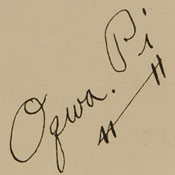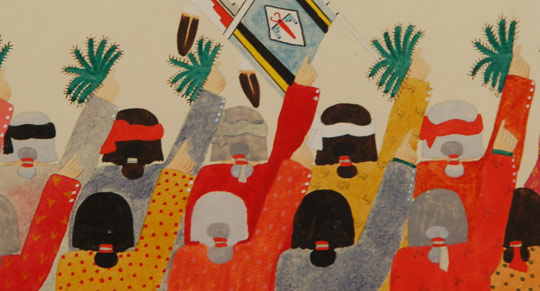Untitled—Chorus of Green Corn Dance [SOLD]
+ Add to my watchlist Forward to Friend
- Category: Paintings
- Origin: San Ildefonso Pueblo, Po-woh-ge-oweenge
- Medium: casein
- Size: 16-1/2” x 11-1/2” image; 24” x 18-5/8” framed
- Item # C3469B SOLD
What may be the catalyst for the development of Pueblo Indian easel art occurred at San Ildefonso Pueblo Day School in the year 1900. It was that year that Esther Hoyt, a U. S. Indian Service school teacher provided watercolor paints and paper to her students and encouraged them to paint scenes of Pueblo ceremonial dances. It is not clear if she was deliberately defying government policy against assimilation of the students into the dominant culture or if she intended to have them express thoughts in paintings because they could not speak English and were forbidden to speak their native language. Regardless of her intent, it succeeded. Within 15 years, these students were selling paintings to museums and individuals in Santa Fe.
Oqwa Pi (Abel Sanchez - Red Cloud) painted in the two-dimensional style, avoiding the use of perspective and realistic modeling. He made brilliant use of color as much for aesthetic effect as descriptive value. He remained true to ethnographic detail. His figures are simplified and stylized and magnified in color.
 Characteristic of Oqwa Pi's style, there are no backgrounds, foregrounds, or ground lines. This tends to make his art charming and true to the folk art style and certainly true to the Santa Fe Indian School style. The fresh color and action and the great simplicity of his paintings made the works of his well received in exhibits at the Milwaukee Art Institute, Yale University, Museum of Modern Art in New York City, Stanford University and the Gallery of Fine Arts in Muskegon, Michigan.
Characteristic of Oqwa Pi's style, there are no backgrounds, foregrounds, or ground lines. This tends to make his art charming and true to the folk art style and certainly true to the Santa Fe Indian School style. The fresh color and action and the great simplicity of his paintings made the works of his well received in exhibits at the Milwaukee Art Institute, Yale University, Museum of Modern Art in New York City, Stanford University and the Gallery of Fine Arts in Muskegon, Michigan.
This painting illustrates the male vocal group during the Green Corn Dance. The men are standing with both feet planted solidly in place while they display evergreen twigs raised up in unison. The banner carrier stands off to the right of the chorus. The painting concentrates on the group of men and is devoid of ground plane, plants or clouds. The image of the men fills the entire painting. There is an almost identical painting in the collection of the School for Advanced Research which is dated 1925-1930. This painting would be of the same period. It is framed in a hand carved dark brown wood frame made by Tres Mowka of Santa Fe.
Condition: appears to be in original condition but has not been examined out of the frame
Provenance: from the collection of a Santa Fe family
Recommended Reading: Pueblo Indian Painting: Tradition and Modernism in New Mexico, 1900-1930 by J. J. Brody, 1997

- Category: Paintings
- Origin: San Ildefonso Pueblo, Po-woh-ge-oweenge
- Medium: casein
- Size: 16-1/2” x 11-1/2” image; 24” x 18-5/8” framed
- Item # C3469B SOLD



